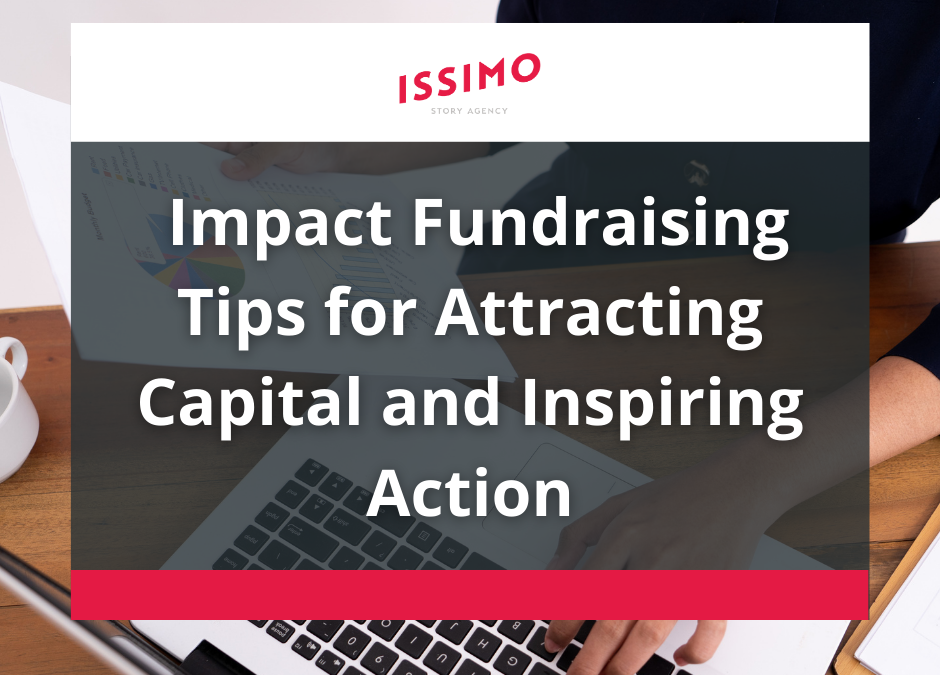Tell the Right Story to Increase Your Impact Fundraising Success
Only 18 percent of impact organizations are seeing the results they want from their communications, according to our attitudinal research study about how impact and for-good organizations can be more effective fundraisers. What causes this gap in storytelling effectiveness?
At ISSIMO, we believe the secret to impact fundraising success is telling your story in a way that inspires your audience to join your mission. When they see the value in what you do, it’s much easier for them to invest in your organization.
Start by Simplifying Your Brand Story
A compelling story doesn’t have to be long or complex. Speaking directly to investors and donors doesn’t require crafting your own thousand-page epic. In fact, telling the right story in the right way is simpler than you may think.
“If you confuse, you lose.”
— Donald Miller, CEO of StoryBrand
Aim for simplicity because often, less is more. Balance is key. You can oversimplify to the point of being trite or cliche. It’s also easy to lose your audience with too much complexity.
Every story is inherently reductive. You can never include all the details and description. The full story of your life takes a lifetime; anything else is representation. You’ll know it’s hit the right balance if it rings true to you and your audience. The nexus between your audience, organization and impact is where the storytelling gold lies.
“We are all storytellers. We all live in a network of stories. There isn’t a stronger connection between people than storytelling.”
— Jimmy Neil Smith, founder and president emeritus of the International Storytelling Center
Your story needs to live inside the hearts and minds of your audience. To have staying power, it needs heart. That doesn’t mean you’re creating a tagline. In fact, your audience may never hear it. But it should be central to what they feel.
Estee Lauder famously said she doesn’t sell cosmetics; she sells hope in a bottle. That core emotional benefit is what your audience wants on a deep level — it goes beyond the practical features of the product.
For Triodos Investment Management, their story boils down to the idea of Bold Authenticity — impact that’s in their DNA, baked into a cake that’s not just sprinkles on top. Their message resonates with those investors who care about authentic, deep green impact results.
Your story’s job isn’t to tell your audience everything they need to know about you. Instead, it should communicate what the audience needs to feel confident in taking the next step.
Most impact organizations we surveyed strongly agree that speaking to significant impact and results from their work should increase fundraising success. But there’s more to it than that. You need to find the balance between the head (the business case for your work) and the heart (the emotional value of what you do). The audience needs to resonate with your message quickly and deeply. It needs to compel action
Elements of Effective Storytelling
If you’re struggling to reach your fundraising goals, you’re not alone. Our study shows there’s room for growth, especially in terms of how effectively you:
- Make your story financially compelling
- Make your story visually interesting
- Achieve an emotional response
The details may vary depending on what your organization does, but the core elements of effective storytelling are the same.
- Be you not them. What makes your organization weird in a good way? Tell a unique story that makes your organization stand out.
- Speak to the head and the heart. Both need to be woven into your story to compel action.
- Play the right role. Center your audience as the hero in your story and your organization as the supporting cast. Take them on a journey where the end result is meaningful to them.
- Be a problem solver. Speak to a core emotional benefit and address what gets in the way of your audience getting what they want using clear, concise language.
- Tailor your message to your audience. This includes where they are, how they speak and what their biases are.
When you follow these principles, you can get more bang out of the resources and bandwidth you have.
At ISSIMO, we believe these core elements are best reflected in visual storytelling. Our study found that most respondents also agree that visual storytelling would make their fundraising efforts more effective. The medium used to tell visual stories — video, photography, infographics, pitch decks, etc. — doesn’t matter as much as how you build them. Despite most respondents using a wide range of visual mediums, only 18 percent give their visual elements excellent ratings on effectiveness.
If you follow these storytelling best practices and infuse visual elements with messaging that speaks to your audience’s head and heart, fundraising success is much more likely.
Storytelling That Leads to Impact Fundraising Success
One thing that can get in the way of telling the right story in the right way to the right people is the clarity decay curve — a barrier to effective storytelling we identified in our research.
Think of it like a game of telephone. It starts at the top with leadership and where the story lives in their heads. Information gets passed down to teams and external stakeholders, which becomes transformed, exaggerated or miscommunicated. Just like that, your impact objective can diverge from the heart of what you do to cause internal contraction and external disconnection.
To combat this, make sure everybody within your organization has a crystal clear understanding of your impact objective. Take some time to assess where you’re at. How well does everybody in your organization understand your impact objective? If you asked each of them to describe it, would their answers be the same? This may make all the difference in how effective your impact story really is.
To learn more about each segments’ behaviors and how you can tell the right story, check out our entire executive summary. And to explore the data yourself, check it out here.

